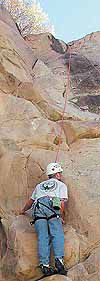| cutline goes here |
Rock climbing is the fastest growing sport in the world. This is mostly due to the recent boom of indoor climbing areas across the country and to portable outdoor walls that make climbing possible anywhere, anytime. Most recreation centers built today include a climbing area.
“When we started doing rock climbing classes some 10 years ago, we filled every class we offered and had a waiting list of people who wanted to take one,” says Christensen. “Today we teach one or two classes a year with maybe five or six participants. Yet, there are more climbers than ever.”
What has changed?
Two things, explains Christensen. First, he says, is all the people who have been trained by Carbon County Recreation, and the people who have been trained by others. The problem is, not all climbers are being trained adequately, or even properly. The second consideration, explains Christensen, is people’s perception of risk. Indoor climbing gyms are very safe. Rock is not.
“We see dangerous things all the time,” explains Recreation climbing instructor Paul Bedont. “People think they’re doing things safely because they don’t know any better.” Bedont tells about a situation he encountered just a few weeks ago where some young people in Spring Canyon were using very inadequate anchors. He took the time to help them understand anchor systems.
Christensen loves to quote John Long, one of the most respected rock climbing instructors in the country. Long says, “If you ain’t got a great anchor, you ain’t got nothin’.”
That is absolutely true explains Christensen. People often trust inadequate anchors and the result can be tragic. Rarely do we trust one anchor, Christensen explains. Once in awhile when the anchor is “bombproof,” which means there is no way it can fail. For instance, a healthy eight-inch tree. Otherwise, we teach two anchors are minimum. If either is suspect, then use three. And the number of anchors isn’t the only consideration. The way the ropes are tied to the anchors is just as important. The key is to equalize the load across the anchor system. If that isn’t done properly, then the entire load can be placed on one anchor, even in a multianchor system.
If the people you’re climbing with don’t know that, then you shouldn’t be climbing with them.
It’s one of many aspects of rock climbing where what you don’t know can kill you, explains Christensen. And that’s not an exaggeration. People die across the country every month because they’re doing something they shouldn’t be, or more likely, not doing something they should be.
So, whom can you trust? Christensen recommends taking a climbing class from a respected instructor. “We have taken over 900 people on climbing and rappelling outings and the worst injury we’ve had has been a skinned knee,” Christensen says.
| Paul Bedont, instructor, assists Parker Cammans prepare his ropes for the climb. |
Christensen is quick to point out there are lots of qualified people in the community who really know what they’re doing. But, there are people doing a lot of things they shouldn’t be, and teaching others to do things improperly. Knowing the difference is not only imperative, but can save your life.
“I really wonder if parents know what their children are doing?” Christensen asks. If not, perhaps they should ask. It’s a common concern about teenagers that they know everything, and climbing is no different. “I can’t tell you how many times I’ve heard, “Mom, I know what I’m doing.” And they don’t. It’s that simple.
Christensen said he was in Spring Canyon a few weeks ago and watched three teenagers climbing. The knots they were using were totally inadequate, and they were binding their anchors. Those are two things that can quickly cause tragedy.
So, should parents tell their children they can’t climb? No, just make sure they get the training they need to keep them safe, suggests Christensen.
Carbon County Recreation is starting a new program that may help. “At the present time we’re calling it an Adventure Club,” Christensen says. “But we may get more creative with a name once we start having meetings and outings.”
The idea behind the club is to get people who have skills to help beginners and people with questions. Christensen encourages the entire family to become involved. The club will have an annual fee of $20 per person or $40 for the entire family. The money will go mostly to purchase ropes. That’s the only expense in rock climbing that is constant, Christensen explains.
An organizational meeting for the club is scheduled for Oct. 21 at 5 p.m. at the Recreation Office. As an added bonus, Carbon County Recreation will provide a free climbing workshop for anyone who signs up for the club in October.

